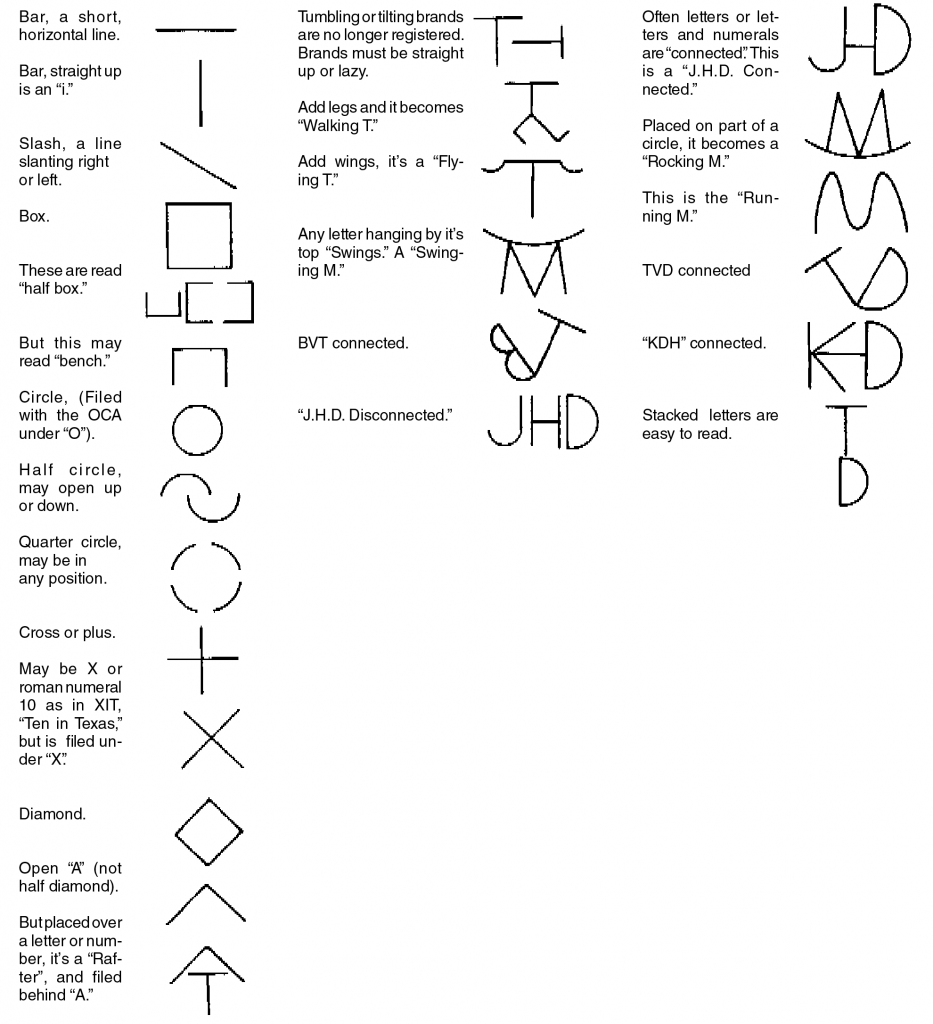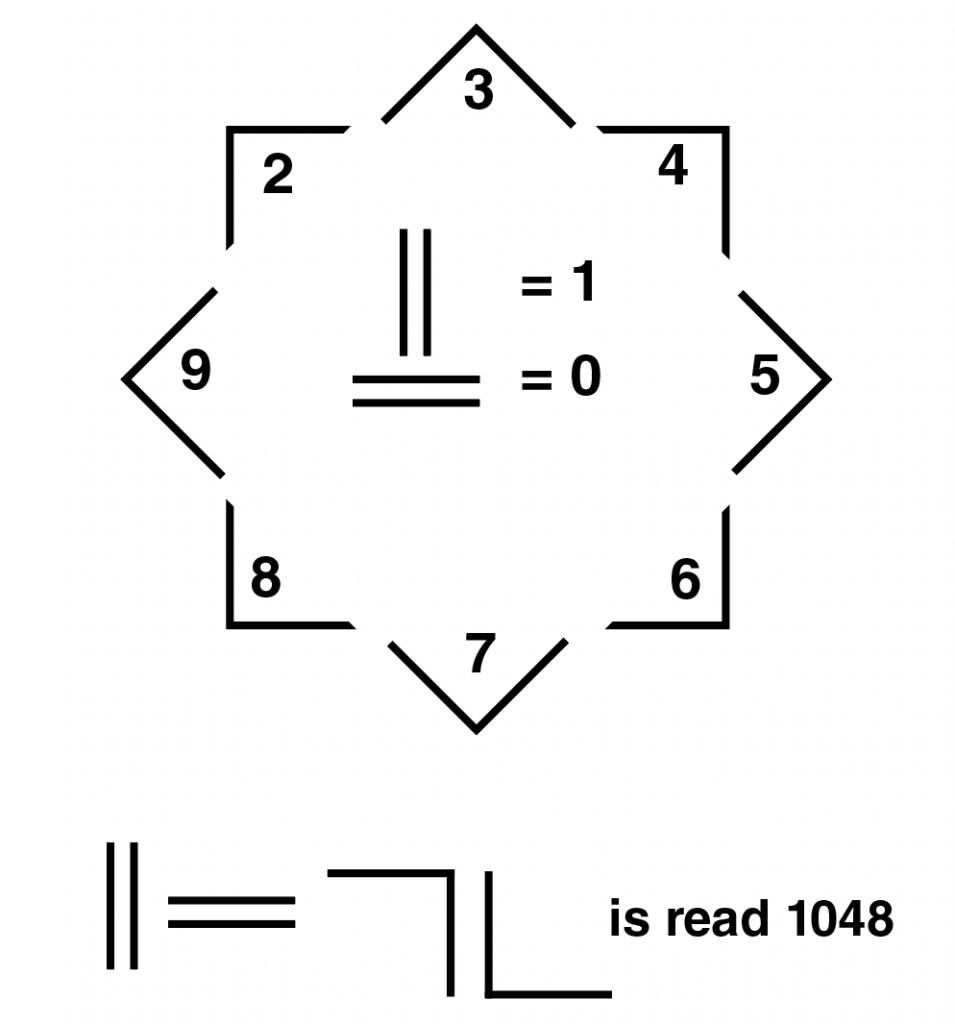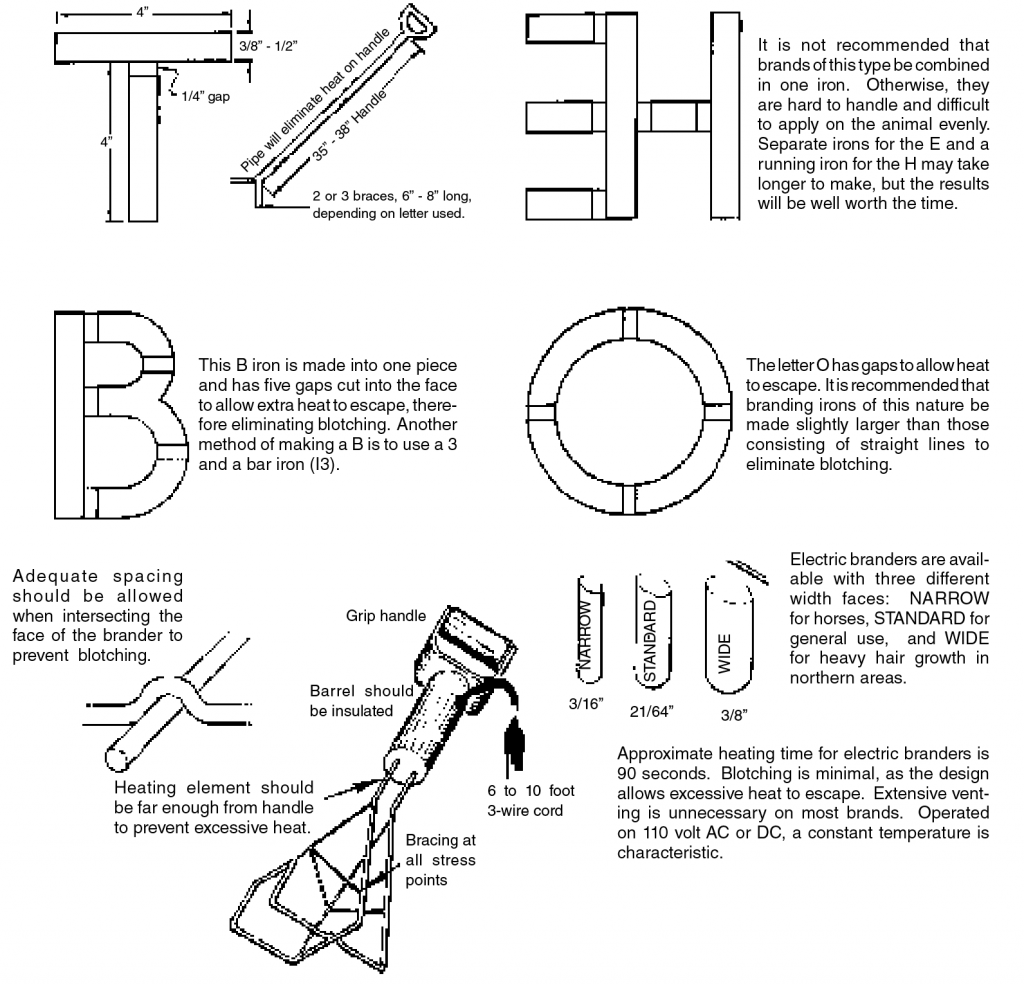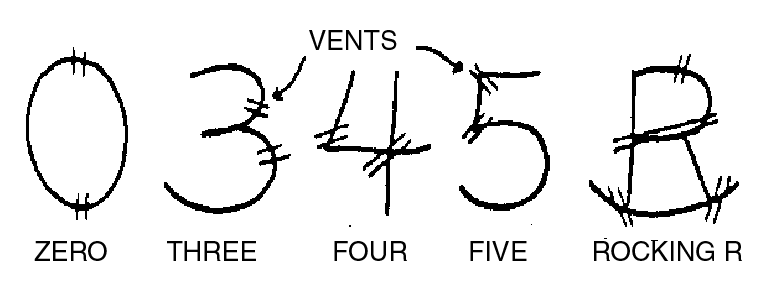How To Register A Brand In Oklahoma
Livestock Branding in Oklahoma
Past David Lalman, Cassie Danielson, Michael Kelsey
- Leap To:
- Why Brand?
- Summary of Oklahoma Brand Laws
- Where, When and How to Make
- Tips on Fire Branding Procedures
- Freeze Branding
- How to Read a Brand
The beef cattle industry is a dynamic business that must continually adjust to market signals, public opinion, state and national policies, and other industry issues. Branding cattle to show buying, legal title, and record keeping have been promoted and practiced by cattlemen in the western states for the past 150 years. However, in contempo years, questions have been raised concerning the humane treatment of cattle with respect to certain management practices, and the impact of those practices on the overall value of a beef product and/or past-products.
According to the 2016 National Beefiness Quality Audit, of the $49.06 lost per head to the beef industry due to discounts for various carcass defects, and quality issues, only 98 cents of that loss was due to brands and/or other hide defects. This reduction in value (toll) due to hide defects is compatible to $1.95; 1.ninety; 2.39; 2.67 and two.43 in beef quality audits conducted in 2011, 2005, 2000, 1995 and 1991, respectively. This improvement suggests that more producers take moved the location of the make from the rib to the hip, thus restoring more value to the hide.
The 2007-2008 USDA National Animal Health Monitoring Arrangement study of 2,872 beef moo-cow/dogie operations in 24 of the nation'southward major beef-producing states represented fourscore percentage of all cow/calf operations, and 88 percentage of all the beefiness cows in the U.South. The study showed that the hot iron make was used on 12 percentage of all the operations and was the source of identification on 21 percent of all the cows in the study. The freeze make was used on 2.iv percent of all the operations surveyed, and identified four percent of all the cattle in the study.
Why Brand?
Branding today is nonetheless the almost recognized and accepted means of indicating buying of cattle in North America. Eventually, other methods such as electronic "chipping" may become the standard for identification, but until this procedure becomes a more economical and applied alternative, producers will go on to utilize the fourth dimension-tested, permanent and universal method of branding.
Summary of Oklahoma Make Laws
Those applying for state make registration must complete and file the Application for Registration of Brands and Marks (found at: http://www.okcattlemen.org/brand-registration) with the Oklahoma Cattlemen's Association Brand Division, P.O. Box 82395, Oklahoma City, Oklahoma 73148. The awarding must be accompanied past a $40.00 registration fee. Upon blessing, a brand document will exist mailed to the applicant indicating the brand registered. All brands canonical by the Oklahoma Cattlemen's Association (OCA) will announced in the following brand volume or supplement printed.
All brands must be renewed at the beginning of each five year registration period, regardless of when the make was registered. State registered brand owners will be notified past mail before the five year registration period ends. At this time, brands are renewed prior to publication of the newest Oklahoma Brand Volume.
- A brand is divers as a permanent mark not less than 3 inches in length or diameter and burned into the hide with a hot atomic number 26. "Freeze branding" is also a form of identifying creature buying. Acid brands are not recognized every bit state registration.
- Single unit brands including ane initial, number, bar, slash or quarter circle are not accepted as forms of state registration.
- Each brand registration must be confined to 1 location on the animal. When the same brand is used on two sites, two applications must be filed. Brands must be registered in the following eight positions But: left neck, left shoulder, left rib, left hip, right cervix, correct shoulder, right rib and right hip. However, previously registered Oklahoma make positions are non affected (O.S. 2, Sections 405). The left jaw is reserved for the use of B and T brands, identifying cattle having a detectable antibiotic titer for Brucellosis and Tuberculosis.
- Applicants are required by law to list, in order of preference, three distinct brands and three positions on the beast for awarding of the brand.
- State registration of your brand is not required by constabulary. Recorded brands, however, accept precedence over similar unrecorded brands when questions of ownership arise, placing the burden of proof on unregistered brand users in the result of controversy. Registered brands are prima facie evidence of buying in a court of law.
Make books are furnished to county sheriffs, canton extension agents, vocational agricultural instructors, and libraries without charge. They can exist purchased by the public from OCA at a toll equal to the price of preparation, printing, and delivery.
Where, When and How to Make
When ownership brands are applied it is all-time to use hot brands. The clarity of the awarding can be adamant shortly after branding, and creature-to-beast variation does not bear upon the end results as greatly as with freeze branding. A good hot make is recognizable because it destroys hair follicles located under several layers of skin and leaves a permanent baldheaded scar on the hibernate of the beast.
Identification and ownership brands can exist applied at any fourth dimension during the year, but this process is usually performed in combination with one or more practices such as weaning, castration and vaccination. Calves are usually branded before or during weaning because the probability of a calf straying is greater after weaning.
Good brands can be achieved past properly heating the irons until they appear a argent-gray (similar to the colour of ashes) in the daylight, but glow a cherry-scarlet color when held in a dark area. Clipping excessive pilus growth or mud from the hide area to be branded, and keeping irons clean at all times with a steel brush to remove hair, dirt and other droppings are direction practices which should exist utilized. The irons tin can be heated in a wood fire (bed of coals) or a propane (bottled) gas fire. An electrical branding atomic number 26 can exist used successfully after a certain amount of feel is gained.
The size of the iron is important. Each character should be (in outside measurements) 4 inches by 3 inches for calves less than 1 twelvemonth erstwhile and 6 inches by three 1/ii inches for older cattle. The face width of the branding iron should be i/4 inch to 1/two inch wide, with the surface edges slightly rounded. All circles and corners should be vented to forestall excessive scarring. Over again, in utilizing the "value added" approach, the branding location is restricted to the hip. This should exist the outset consideration, as the brand registry may require an applicant to move their chosen location (thigh, shoulder) or choose a different blueprint in club for the brand to be registered.
Tips on Fire Branding Procedures
Catch the dogie's caput in the headgate of a squeeze chute, then squeeze to restrict motility. Heat the branding irons to the proper temperature as previously described. Firmly press the ash-grey colored branding fe confronting the hibernate and rock the handle slightly to vary the pressure, allowing for uniform application of the entire character.
The color of the branded hide should be light tan, like to the color of new saddle leather. If the atomic number 26 is the proper temperature and the cattle have a low-cal (summer) hair coat, the brand should exist held for no more than than three to five seconds. Cattle with a heavy (winter) hair coat should be clipped before branding. Otherwise, the brand requires an application of v to 10 seconds.
Do not brand wet animals. An atomic number 26 applied to a wet animal loses temperature rapidly and tends to scald rather than burn the hide. The result is a serious, wearisome-healing scar that is hard to read. Apply one iron at a time, taking caution to avoid slippage on the hide. Place brand numbers or characters at least one inch apart. Exist sure the branding fe is clean and free of hair before it is used again.
If a second application is necessary to "touch-up" a spot, or more burn is needed, the procedure should be washed with farthermost care. The iron must be placed in the verbal position of the commencement awarding then the character does non blotch.
It is best to brand when flies are non a problem. If they are present, utilize a small corporeality of insecticide to the brand area to prevent infection. A light awarding of oil or grease to the area volition also aid in smoother, faster peeling.
Freeze Branding
Freeze branding (cryogenic branding) of cattle with super-chilled irons has been developed within the past thirty years, and is recognized every bit a legal method of buying and animal identification in Oklahoma. With this method, the hair of a freeze branded animal is discolored or white due to impairment by contact with farthermost cold to the melanocytes (colour producing cells) of the hair. Nonetheless, the Oklahoma Cattlemen's Clan recommends that hot iron brands be used for ownership purposes.
Freeze branding has not fulfilled all of the early on expectations for the technique, though some people have been satisfied with the results. Drawbacks of the procedure include:
- Brand sites need to be clipped in the winter for complete clarity.
- The process is relatively expensive on small numbers of cattle.
- Visibility of the brand is not as distinct on xanthous, white, or blood-red cattle as on blackness cattle.
Freeze branding materials include:
- Hair clippers, castor, and squirt bottle.
- Branding irons (preferably copper, or brass heads).
- Insulated container for coolant.
- Alcohol (95 percent ethyl, methyl or isopropyl) or acetone.
- Dry water ice or liquid nitrogen.
Tips on Freeze Branding Procedures
Factors critical to the success of freeze branding include properly cooled irons, compatible pressure on the make site, and correct timing.
Key steps of the procedure include:
- Cool irons in alcohol and dry ice or liquid nitrogen.
- Restrain the beast in a headgate and squeeze chute.
- Clip area to be branded closely.
- Clean brand site by brushing and wet thoroughly with alcohol from a eject canteen or sponge.
- Firmly concord the atomic number 26 in place on the brand site for the necessary time.
| Timing | Calves | Mature Cattle |
|---|---|---|
| Alcohol and Dry Ice | 40 seconds | sixty seconds |
| Liquid Nitrogen | 10-15 seconds | 22-25 seconds |
How to Read a Brand
Brands are read from left to correct, top to bottom and outside to inside. Figures, symbols, letters, and numbers will become easily recognizable with practice (meet Effigy 1). An alternative to the more customary and traditional brand symbols is the bending make system (see Figure two). This universal identification organisation is based on 2 concentric squares designed by USDA Agricultural Research Service workers.
In the basic foursquare, numbering starts with 2 (in the top left corner) and continues clockwise to the other 3 corners as 4, vi and 8. Odd numbered angles are indicated by a 2d foursquare rotated 1/8 of a plow to the right (clockwise). The top angle (corner of second square) is designated as the number 3 with the 5, seven and 9 angles post-obit in the same clockwise manner. Two adjacent vertical lines, every bit with the number "11," represents the number one. Two next horizontal lines, or an "equals" sign (=), depicts the number 0.
These identification marks tin can be applied with either hot or cold branding techniques. Furthermore, these angles proved to exist more easily read than numbers in recognition trials.

Figure 1. Traditional Brand Symbols

Figure two. Bending Brand System

Figure 3. Constructing and Branding Iron.

Figure 4. Branding irons should be vented to forestall excessive scarring.
David Lalman
Extension Beefiness Cattle Specialist
Cassie Danielson
Brand Registrar, Oklahoma Cattlemen's Association
Michael Kelsey
Executive Vice President
Oklahoma Cattlemen'south Association
Was this information helpful?
YESNO
How To Register A Brand In Oklahoma,
Source: https://extension.okstate.edu/fact-sheets/livestock-branding-in-oklahoma.html
Posted by: salinasdelitth.blogspot.com


0 Response to "How To Register A Brand In Oklahoma"
Post a Comment